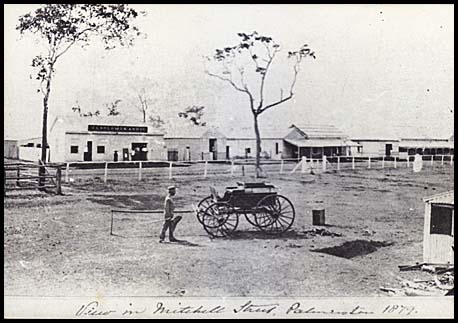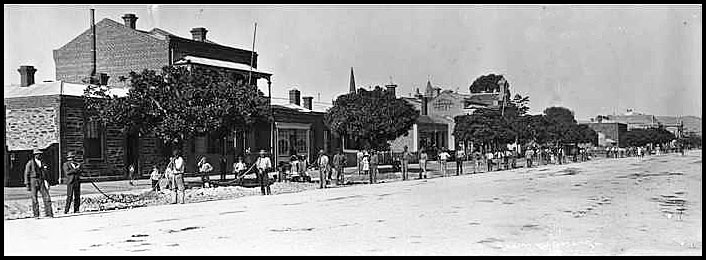The establishment of Darwin.
- Home, index, site details
- Australia 1901-1988
- New South Wales
- Overview of NSW
- Telegraph lines
- Telegraph Offices
- Date stamps
- Forms
- Envelopes
- Rates
- Stamps
- Queensland
- Overview of Qld
- Telegraph lines
- Telegraph offices
- Date stamps
- Forms
- Envelopes
- Rates
- Stamps
- South Australia
- Overview of SA
- Telegraph lines
- Telegraph Offices
- Date stamps
- Forms
- Envelopes
- Rates
- Stamps
- Tasmania
- Overview of Tasmania
- General developments
- Reports
- Organisation
- Telegraph lines
- Telegraph Offices
- Date stamps
- Railway lines
- Forms
- Envelopes
- Rates
- Stamps
- Overview of Tasmania
- Victoria
- Overview of Vic.
- Telegraph lines
- Telegraph offices
- Date stamps
- Forms
- Envelopes
- Rates
- Stamps
- Ephemera
- Western Australia
- Overview of WA
- Telegraph lines
- Telegraph Offices
- Date stamps
- Forms
- Envelopes
- Rates
- Stamps
There were three stages leading to the establishment of Darwin by the Government of South Australia:
- the first attempts to establish a settlement on Australia's north coast by England at Port Essington;
- the change to the administration of the Northern Territory by the Government of South Australia;
- the establishment of an outpost in the Northern Territory to which the cable from Java could be connected.
1. The British attempts to begin a Colonial outpost.
The area in the north of Australia had been administered by Britain since
2. The early administration of the Northern Territory.
In 1863, the British Government handed responsibility for the Territory to the South Australian Government.
Prior to the hand-over, the town of Palmerston was established as the "capital" of the remote region and it was surveyed during the early 1860s and some buildings erected.
Along the coast was a strip of land which was referred to as Port Darwin.
3. The establishment and population of Darwin.
| When the possibility of the cable from England to Java being extended to Australia became more likely, the South Australian Government decided to develop the Port Darwin-Palmerston area further.
A special party, under the charge of the Surveyor-General George Goyder, was sent to lay out the street plans for a capital to be named Palmerston. In late 1868, Goyder and his team of about 128 men left Port Adelaide on the Moonta and, on 5 February 1869, arrived in Darwin Harbour. He selected the site on Fort Point near Port Darwin and for nearby townships to be named Daly, Southport and Virginia. A number of newspapers carried reports of the expedition to the northern part of Australia in the following terms: |
 View in Mitchell Street, Palmerston 1877. The Telegraph Office was to the right about 100 yards away. |
The detailed accounts of the expedition to the northern territory confirm the favorable reports communicated by telegraph. Mr. Goyder and party had landed at Port Darwin, had made themselves comfortable, taken a look at the country, and actually commenced their survey before the vessel which had brought them was ready to return.
So far the accounts are favorable. There is a fine harbor, free from any bar, good land, and plenty of water. The climate — although in summer it is difficult and probably unsafe to work during mid-day — appears to be healthful and the worst enemies of the settlers are sandflies and green ants. The country, so far as it has been examined, consists of ridges and table lands of open forests with gum, grevillea, iron and stringy bark, box, two varieties of cedar, pine, cypress and three kinds of palm.
The paperbark and cork-screw palm — the former so called from its curious coats of bark which are said to be immediately available for writing purposes; the latter from its twisted shape - are found in gullies and marshy places. There seem to be no large animals but shellfish abound, and there are innumerable birds with all the splendor of tropical plumage.
The sites of three townships have been fixed and the necessary surveys are in progress. Mr. Goyder states in his report: I am very pleased with what I have seen. South Australia has no reason to fear her connection with this place. Sooner or later it must turn out well. The country, so far as I have seen it, is a first class country for large stock, such as horses and cattle. Even as it now exists, with all its rank, uncropped vegetation, the soil on the slopes, valleys and parts of the table-land, is well-suited for cultivation and mostly rich. The timber is fine and suitable for nearly all purposes. We hope that the anticipations of the energetic Surveyor-General may be realised and that he and his assistants may, as they have promised, eat their Christmas dinner in Adelaide after their arduous survey has been completed.
Advertisements appeared in South Australian newspapers encouraging people to resettle to Darwin:
The South Australian Government made an announcement which the South Australian Advertiser of 15 April 1870 noted in the following terms:
"Northern Territory: An advertisement has been issued by the Government, requesting people who wish to proceed to the Northern Territory to make early application so that some idea may be formed as to the number likely to go. We believe several persons have already attended at the Crown Lands Office and stated their intention of going. The Government have not yet decided whether there shall be a public drawing of lots in Adelaide as to the order in which the selections are to be made".
Private entrepreuneurs saw this announcement as a challenge and some set themselves up as agents. Examples of the suggestions from such enterprising souls appeared in the press - examples from the South Australian Advertiser of 14 April 1870 are:
| Professional and Trade addresses. | |
Northern Territory: Mr. H. B. Hall, being about to proceed to Port Darwin for the Selection of Sections begs to offer his services to Land-Order Holders. Careful attention, added to the experience of a member of the Survey Party, will ensure every precaution being taken to watch the interests of those who may favour him with their instructions. Particulars can be obtained and all information given by addressing H. B.Hall Waymouth Street. |
|
Northern Territory: The undersigned will, prior to the allotment of lands, proceed to Port Darwin (should sufficient inducement offer) and undertake the Selection of Sections for land-order holders. From his general knowledge of the country, he trusts to place his constituents as regards their sections in positions second to none. As horses and suitable equipment will be necessary accompaniment for the further thorough examination of the surveyed lands prior to selection, arrangements for that purpose need to be made at once. It is therefore necessary that applications be made up to, and not later than, the 20th inst. when they will meet with immediate attention. When terms will be stated. John McKinlay, Oaklands, Gawler. |
By the time Todd sent XX to Port Darwin to commence construction of the Overland Telegraph Line in XX 1871 there were about XX people living in Palmerston.
| In July 1907, Palmerston was incorporated into Port Darwin and then, in April 1911, Port Darwin was renamed Darwin at the time when the Northern Territory became a separate administrative unit under Commonwealth control. |  Grote St Darwin in 1902. The new telegraph cable is being laid. Source: National Library of Australia B5281. |
The Palmerston name was resurrected in 1980 as the name of a satellite township to the south of Darwin.